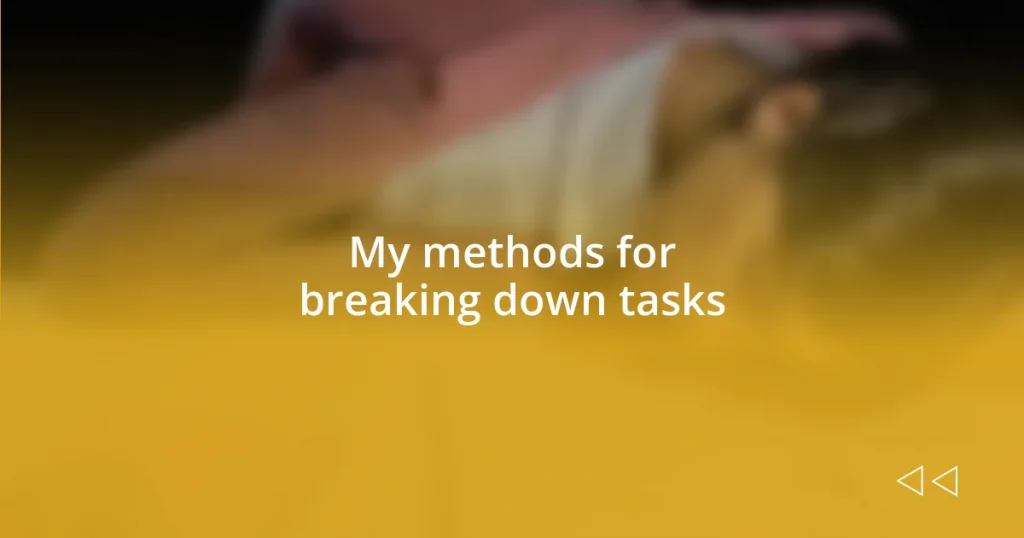Key takeaways:
- Task breakdown techniques, like SMART goals and mind mapping, transform overwhelming projects into manageable steps, enhancing clarity and motivation.
- Setting clear goals provides direction and priority, helping to reduce procrastination and improve focus on important tasks.
- Tools such as digital apps (e.g., Trello), Google Calendar, and handwritten lists are essential for organizing tasks and tracking progress effectively.

Understanding task breakdown techniques
Understanding task breakdown techniques can transform overwhelming projects into manageable steps. I remember the first time I faced a seemingly insurmountable task at work; it felt daunting, and I was paralyzed by the scope of it. I asked myself, “What if I could just tackle this bit by bit?”
One effective method I often use is the SMART technique, which stands for Specific, Measurable, Achievable, Relevant, and Time-bound objectives. By applying this framework, I can see my progress more clearly. It’s satisfying to tick off even the smallest steps; it builds momentum and keeps motivation high.
Another approach I find helpful is creating a mind map. I vividly recall using this method during a major project at university. It allowed me to visualize connections and dependencies, making the task less intimidating. Have you ever tried mapping out your thoughts? It’s like turning chaos into clarity and can make the process feel more creative and enjoyable.

Importance of setting clear goals
Setting clear goals acts as a roadmap that guides me through my tasks, providing direction and focus. I remember when I was preparing for a big presentation; without specific goals, I felt lost. But once I decided to aim for a clear outcome—like mastering the content and engaging the audience—I found it much easier to structure my preparation. This focus not only alleviated my anxiety but also enabled me to channel my efforts effectively.
- Clear goals help to prioritize tasks, ensuring that I address the most important elements first.
- They enhance motivation by giving me a clear destination, making it easier to stay on track and measure progress.
- Setting specific targets helps reduce procrastination, as I have defined what needs to be accomplished at each step.
Every time I set a clear goal, I feel a sense of purpose that drives my actions. I’ve learned that when the pathway is defined, each step feels achievable, and that can significantly boost my confidence and productivity.

Steps to analyze tasks effectively
To analyze tasks effectively, the first step I take is to break the task down into smaller, manageable components. This allows me to focus on one aspect at a time, reducing the feeling of overwhelm. I remember a project that involved multiple stages; initially, I was bogged down by the entirety. Once I started pinpointing critical elements and listing them out, it transformed the task. I felt a flicker of excitement when I realized how approachable it became.
Next, I prioritize these components based on urgency and impact. I’ve found that using the Eisenhower Matrix—dividing tasks into four quadrants based on importance and urgency—can bring clarity. This method has saved me countless hours of stress. When I really had to ace an important work assignment, it was overwhelmingly busy, but once I organized my priorities, I felt empowered to address what mattered most first. Isn’t it incredible how structuring our thoughts can promote action?
Finally, I set deadlines for each small task. This creates a sense of accountability, encouraging me to stay on track. During my last team project, I recall putting a timeline on each minor milestone we established. The result? We finished ahead of schedule! It’s these small victories that provide motivation and illustrate progress. To me, each deadline acted like a little finish line, fueling my drive.
| Step | Description |
|---|---|
| Break Down Tasks | Divide the task into smaller, manageable components. |
| Prioritize | Organize tasks based on importance and urgency. |
| Set Deadlines | Assign time frames for completing each smaller task. |

Methods for prioritizing tasks
Prioritizing tasks is essential for maintaining focus, and one method that has truly resonated with me is the ABC prioritization technique. It’s simple yet effective: I categorize my tasks into three groups—A for high priority, B for medium, and C for low priority. When I reflect on a hectic day filled with distractions, I realize that this method helped me hone in on what truly mattered. Instead of spinning my wheels, I tackled the “A” items first, which gave me a sense of accomplishment that lifted my spirits.
Another effective approach I’ve embraced is the “2-Minute Rule.” If a task takes less than two minutes to complete, I do it immediately. This habit not only keeps my to-do list manageable but also clears my mental clutter. I vividly recall a day when I overwhelmed myself with little chores that lingered for too long. Once I adopted the 2-Minute Rule, I noticed how those small tasks, once dealt with quickly, created a profound sense of relief. It’s amazing how knocking out minor things can create momentum, isn’t it?
Finally, I often consult my energy levels before prioritizing. I’ve discovered that I’m most productive in the mornings, so I reserve “A” tasks for that time. It’s a personal strategy that’s tailored to my natural rhythms. I remember a period when I would push myself to tackle complex tasks after hours, but I often fell short. Once I began aligning my priorities with my peak energy times, my productivity soared, and I felt more alive at work. This insight reinforced the importance of not only looking at task importance but also considering our unique energy patterns. How do you prioritize your tasks based on when you feel most energized?

Tools for organizing tasks
When it comes to tools for organizing tasks, I’ve found digital apps to be game-changers. For instance, using Trello allows me to visualize my projects in a board format. It’s like having a personal assistant always at my fingertips! I remember a particularly chaotic week where I tried managing everything through sticky notes; I quickly realized that transitioning to Trello not only organized my tasks but also provided me with a clearer overview of my progress.
Another tool I swear by is Google Calendar. I integrate it with my daily tasks, setting reminders that keep me from getting sidetracked. There’s a special satisfaction that comes from seeing tasks lined up, especially when I can block out dedicated work sessions. Just last month, I had a daunting list of responsibilities, but scheduling them into my calendar helped me focus without feeling overwhelmed. Have you ever experienced that exhilarating feeling when everything finally falls into place?
Lastly, I can’t overlook the power of a simple notebook. Writing things down by hand has a unique effect on my brain. I recall a moment of clarity during a slow Wednesday afternoon when I jotted down my tasks instead of relying on my phone. It felt cathartic and helped me commit to my goals. There’s something intimate about pen and paper that a screen can’t replicate. What about you—do you prefer the digital tools or the tactile experience of writing things down?

Tracking progress and outcomes
Keeping track of progress and outcomes has been a major part of refining my task management strategies. I often use a simple checklist to mark off completed tasks. There’s an undeniable rush of satisfaction that comes from seeing a list shrink as I tick items off. I remember a particularly intense project where I felt overwhelmed. Breaking it down into smaller tasks and tracking my progress daily transformed my experience—it turned daunting deadlines into manageable steps. Have you ever felt that weight lift as you check off your list?
I also find it helpful to reflect on my completed tasks at the end of each week. This ritual of reviewing what I accomplished gives me clarity on where I succeeded and where I might need to improve. It’s like holding a mirror up to my efforts, allowing me to appreciate my progress. There was a week when I struggled with time management, but that reflection led me to discover patterns in my productivity. I realized I needed to balance my workload better. Have you sat down to assess your achievements lately?
Visual progress indicators work wonders for me, too. I often create a visual board to capture my goals and outcomes, which lets me see my journey unfold in real time. I vividly recall setting up a board for a fitness challenge, watching my progress in terms of strength and endurance. Each milestone captured brought me pride and pushed me to keep going. How do you visually represent your progress?

Strategies for maintaining motivation
Motivating myself can sometimes feel like balancing on a tightrope, but I’ve discovered some strategies that significantly help. One effective approach I use is setting small, achievable goals. When I’ve tackled a large project, breaking it down into bite-sized pieces makes the task less daunting. I remember a time when I was facing a massive report due, and instead of seeing it as one overwhelming task, I divided it into sections. Each completed section felt like a mini victory that propelled me forward.
In addition to small goals, I often reward myself. After finishing a challenging task, I treat myself to a favorite snack or take a short walk outside. I think this gives my brain a little nudge to keep pushing forward. For instance, after finishing a tough editing session, I’d step out for a coffee break, allowing me to return with a fresh perspective. Have you ever noticed how little rewards can foster a deeper sense of accomplishment?
Collaboration also plays a vital role in keeping me motivated. Sharing goals with a buddy or colleague creates a sense of accountability that can be incredibly energizing. I remember teaming up with a friend to tackle our respective projects last summer. We’d share our progress every week, and that connection kept my spirits high, even when I hit roadblocks. Have you thought about how working alongside someone else could help light that motivational spark?















